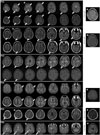Abstract
Background and Purpose
Methods
Results
Figures and Tables
 | Fig. 1Brain abnormalities in neuromyelitis optica spectrum disorder (NMOSD) patients on fluid-attenuated inversion recovery (FLAIR) (upper rows) and T1-weighted enhanced (lower rows) magnetic resonance imaging (MRI) scans obtained at the time of cortical lesion presentation. The brain MRI scans of Patient 2 have been described previously.15 The lesions involving the cerebral cortex are accompanied by leptomeningeal (Patients 1, 2, and 3) or cortical (Patient 4) enhancement, or no enhancement (Patients 5 and 6). In addition to the cortex-involving lesions, other characteristic brain lesions of NMOSD are evident. In representative follow-up FLAIR images (Patients 1, 2, 4, 5, and 6), obtained 3 to 80 months after the presentation of the cortex-involving lesions, most of the lesions had disappeared or become faint—compared to the correlated slices in the previous images (*)—in all patients except Patient 5. mo: months. |
Table 1
Clinical characteristics of neuromyelitis optica spectrum disorder patients with involvement of cerebral cortex in brain MRI

AZA: azathioprine, CBA: cell-based indirect immunofluorescence assay, ELISA: enzyme-linked immunosorbent assay, LM: leptomeningeal, MMF: mycophenolate mofetil, MT: mitoxantrone, N/A: not available, NMO: neuromyelitis optica, NMO-IgG: neuromyelitis optica-immunoglobulin G, NMOSD: neuromyelitis optica spectrum disorder, ON: optic neuritis, RT: rituximab, Sx: symptoms, TBA: tissue-based indirect immunofluorescence assay, WBC: white blood cells.
Notes
Conflicts of Interest Ho Jin Kim has received honoraria for speaking or consulting from Bayer Schering Pharma, Biogen Idec, Genzyme, Merck Serono, Novartis, MedImmune, and Teva-Handok and has received research grants from the Ministry of Science, ICT & Future Planning, Genzyme, Merck Serono, and Kael-GemVax. He serves on a steering committee for MedImmune and serves as an editor of Multiple Sclerosis Journal - Experimental, Translational and Clinical. Woojun Kim, Su-Hyun Kim, So-Young Huh, Jae-Won Hyun, In Hye Jeong, Min-Su Park, Joong Yang Cho, Sang-Hyun Lee, and Kwang Soo Lee have nothing to declare.




 PDF
PDF ePub
ePub Citation
Citation Print
Print


 XML Download
XML Download